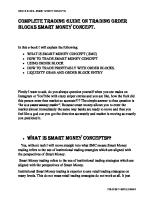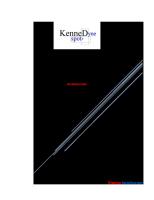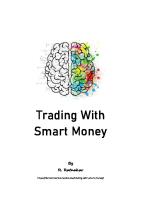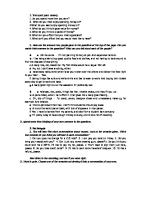True Smart Money Concepts [PDF]
CONTENT 1. The basics 3. Supply & Demand Trend Orderblock theory Consolidation Bullish orderblock Impulse Bearish
34 0 857KB
Papiere empfehlen
![True Smart Money Concepts [PDF]](https://vdoc.tips/img/200x200/true-smart-money-concepts.jpg)
- Author / Uploaded
- Dikgang Malaka
Datei wird geladen, bitte warten...
Zitiervorschau
CONTENT 1. The basics
3. Supply & Demand
Trend
Orderblock theory
Consolidation
Bullish orderblock
Impulse
Bearish orderblock
Retracement Swing points Premium & Discount
4. Liquidity Types of liquidity Buy side liquidity
2. Market structure
Sell side liquidity
Bullish structure
Inducement
Bearish structure
Smart Money Trap (SMT)
Break of market structure (BOS)
5. Putting everything together
Change of character (CHoCH)
Timeframes
BOS vs CHoCH
HTF analysis
Range
LTF entry
Orderflow Multi-timeframe structure
1. THE BASICS TREND A trend is the overall direction of price over a period. Price movement can be upward, downward and even sideways. These movements in price are also known as price action
There are three types of trends in the forex market and these include; ▪ ▪ ▪
uptrend downtrend consolidation (sideways price action)
IMPULSE AND RETRACEMENT Impulse - is the aggresive move of price towards a particular direction. An impulse always comes after a consolidation in price
Retracement - is the correction movement after an impulse movement
SWING POINTS “Swing points in an uptrend (vice versa for the downtrend)’’ We have two types of swing points ▪
Swing low - is the lowest point between two consecutive highs
▪
Swing high - is the highest point achieved by price before the retracement move
PREMIUM & DISCOUNT Premium and discount is the theory of buying at cheap prices and selling at high prices. We use premium and discount by placing the fibbonacci tool on both the swing high and swing low of our current range. The Fibonacci is used to determine the end of the retracement move. In an uptrend, price will usually retrace to the discount before another impulsive move occurs. In a downtrend, price will usually retrace to the premium before another impulsive move occurs.
2. MARKET STRUCTURE Market structure is a representation of the trend in which the market is currently trading in. We have two forms of structure ▪ ▪
bullish structure bearish structure
BULLISH STRUCTURE An uptrend is referred to as bullish market structure. In a bullish market, the market is characterized by making a series of higher highs and higher lows. A higher low is the lowest point that breaks structure to the upside A higher high is the highest point achieved by price before the retracement move
BEARISH STRUCTURE A downtrend is referred to as bearish market structure. The bearish market is characterized by making lower highs and lower lows A lower low is the lowest point achieved by price before the retracement move A lower high is the highest point that breaks structure to the downside.
BREAK OF MARKET STRUCTURE (BOS) “BOS in an uptrend (vice versa for the downtrend)” Break of market structure occurs when price closes above a swing high/low. In an uptrend, when price closes above a higher high, this is considered as a break of structure and indicated that the market wants to continue trading in the direction of the trend. Note: ▪ ▪
After break of structure, always wait for retracement Always trade in the direction of the BOS
A break of structure is only considered valid when price closes above the higher high with a full body, when price closes above the swing high with a wick, this is not considered as a break of structure.
CHANGE OF CHARACTER (CHoCH) CHoCH happens when price breaks a swing high followed by a break of the swing low. OR CHoCH happens when price breaks a swing low, followed by a break of a swing high “CHoCH in the uptrend (vice versa for the downtrend)” In an uptrend, when price closes below a higher low, this is considered as a change of character and signifies that the market is likely to start a new trend.
Note: A new trend can only be confirmed after two consecutive breaks of structure in the same direction
BOS vs CHoCH What is the difference between BOS and CHoCH BOS - represents continuation of a trend
CHoCH - is the first sign of reversal in trend and signifies that the market wants to change from one trend to another.
RANGE A range is price action contained within a swing high and swing low. After BOS, there will always be formation of a new consolidation, that is what we call a range.
ORDERFLOW Orderflow is a trend continuation model which represents how orders are being created and filled in the market. Simply put, orderflow is when price respects previously created ranges. That is to say; ▪
In an uptrend, price will continuously create and respect bullish ranges.
▪
In a downtrend, price will continuously create and respect bearish ranges.
SHIFT IN ORDERFLOW However, when price fails to respect the most recently created range, this is considered as shift in orderflow. Shifts in orderflow are mostly lower timeframe (LTF) reversals and usually happens after a higher timeframe (HTF) break of structure. We can also use shifts in orderflow as entry confirmations to take trades at HTF points of interest (POI).
MULTI-TIMEFRAME MARKET STRUCTURE We view the market in a multi-timeframe perspective by look at both swing structure and internal structure. Where swing structure represents HTF structure and internal structure represents LTF market structure. Let us take an example of an uptrend. In an uptrend price is known to make a series of higher highs and higher lows, this is what we call HTF swing structure, but within this HTF swing structure we have another type of structure known as internal structure. This internal structure is viewed as swing structure on the LTF.
We capitalize on LTF market structure to find intraday trade setups in line with the HTF market structure. How is this achieved? In our previous example we can see that the market is in an uptrend, where the blue line represents the HTF structure and the red line represents LTF structure.
When we look at this LTF structure, what we see is that the LTF was forming higher highs and higher lows during the HTF impulse move. When the HTF forms a higher high, we can see that the LTF also formed a change of character.
Note: ▪
when we see a LTF change of character after a HTF break of structure, this is a sign that the retracement move has likely started and we can use this as a confluence to get into counter trend trades
Even at the formation of the HTF higher low, we can see that the LTF formed a change of character which signified that the retracement move has likely come to an end. Again, we can use this as a confluence to get into pro trend trades.
Please note: ▪
In an uptrend a true change of character must be formed within the discount of the HTF range. If it is formed in the premium of the HTF range, it is considered invalid and we don’t trade from it.
▪
In a downtrend a true change of character must be formed within the premium of the HTF range
3. SUPPLY AND DEMAND Supply and demand is what determines market direction. That is to say, when the demand is high price moves up, and when supply is high price moves down. In simple terms, in an uptrend demand is in control and in a down trend supply is in control
The market is an interaction between buyers and sellers and through supply and demand we can get to know who is in control where demand represents buyers and supply represents sellers. At the start of every impulse move, there is either demand/supply that led to this impulse.
After every impulse, there is always a retracement before a continuation.
No one knows what the market will do next, that is why we only look to get into continuation trades.
ORDERBLOCK Orderblocks are candles where market markers (banks) have placed their positions, the market usually returns and respects these orderblocks. There are two types of orderblocks; ▪ ▪
bullish orderblock bearish orderblock
BULLISH ORDERBLOCK The bullish orderblock is the last bearish candle before the impulsive bullish movement that breaks the market structure high
BEARISH ORDERBLOCK The bearish orderblock is the last bullish candle before the impulsive bullish movement that breaks the market structure low.
These orderblocks are our true supply and demand zones. When marking supply/demand zones, we draw a rectangle around the high and low of the orderblock.
How to identify supply and demand Step 1: identify the trend. This is essential because we know in an uptrend demand is in control and in a downtrend, supply is in control Step 2: Mark up the swing points with their corresponding breaks of structure.
Step 3: Find and markup orderblocks within the previous range. When the market taps into a demand/supply zone, we are likely to see a continuation
4. LIQUIDITY For a trader to buy/sell a currency pair, there must be another trader with an opposite position. The existing facility to place these positions in the market is called LIQUIDITY. Liquidity is defined by stoplosses, where the stoplosses exists is where the liquidity also exists. Banks/institutions need to activate the stop losses of existing orders in the market so that they can place their positions in the market. Why do banks manipulate price? Banks initiate large trading volumes and sometimes find it difficult for some of their trades to be filled in, so they manipulate the price so that they can have their positions filled in the market. There are two types of liquidity in the forex market, these include; ▪ ▪
Buy side liquidity (BSL) Sell side liquidity (SSL)
BUY SIDE LIQUIDITY (BSL) We view buy side liquidity as stoplosses of sell orders. After BSL is taken, the market reverses to the downside because banks use BSL to place sell orders in the market. Examples of BSL
SELL SIDE LIQUIDITY (SSL) We view sell side liquidity as stoplosses of buy orders. After SSL is taken, the market reverses to the upside because banks use SSL to place buy orders in the market. Examples of SSL
INDUCEMENT We view inducement as liquidity that lies below/above our points of interest.
SMART MONEY TRAP (SMT) A smart money trap is an area where SMC traders are tricked into trading on the wrong side of the market.
When price closes above a swing high/low with a wick, the demand/supply zone it creates is invalid and this is what we call a smart money trap.
A lot of SMC traders will look to trade from this SMT zone and will usually be stopped out most of the times.
Note: ▪
Sometimes price may respect the SMT zones, but to be on a safer side, never take trades in an SMT zone
5. PUTTING EVERYTHING TOGETHER In this chapter we will discuss how to use all the above concepts as confluences for taking trades. Factors of confluence ▪ ▪ ▪
Timeframe HTF analysis LTF entries
TIMEFRAME For swing trading Analysis: Weekly, Daily, Entries: H4, H1
For day trading and scalping
Analysis: H4, H1, M30, M15 Entries: M15, M5, M1,
HTF ANALYSIS Step 1: Determine and mark up the current HTF swing points
Step 2: Determine and markup the current range and apply the fibbonacci tool on both the swing high and swing low. Note: ▪
In an uptrend only take trades from the discount of the HTF range.
▪
In the downtrend only take trades from the premium of the HTF range.
▪
Markup supply zones in the premium of the current HTF range if at all the market is
Step 3:
in a downtrend OR ▪
Markup demand zones in the discount of the current HTF range if at all the market is in an uptrend
Note: ▪
Only take trades that are in line with HTF orderflow. That is to say in an uptrend, we will only be looking for buys and in the downtrend, we will only be looking for sells
After you are done with the above steps, wait for the market to approach your point of interest (POI) and when it does, go to the LTF and wait for entry confirmations.
LTF ENTRY When the market approaches our HTF POI, wait for a LTF shift in orderflow
Step 1: When we get a change of character (CHoCH) on the LTF, markup the range that led to the CHoCH
Step 2: Markup the orderblock within the range that caused the CHoCH.
Step 3: Place an entry on the supply/demand zone you marked up with the stoploss above the supply zone if it’s a sell. Place the stoploss below the demand zone if it is a buy.
If you’re still having challenges learning and mastering smart money trading from the above information, feel free to use my personal Instagram or Telegram for inquiries by sending me a DM
Instagram: https://instagram.com/fxblueprints?igshid=YmMyMTA2M2Y= Telegram: https://t.me/fxblueprints YouTube: https://www.youtube.com/channel/UC6lU8bf-hSAfWu_u3XsG3KQ
THANK YOU FOR READING “I CAN’T WAIT TO SEE YOU PROFIT FROM THE ABOVE CONCEPTS”









